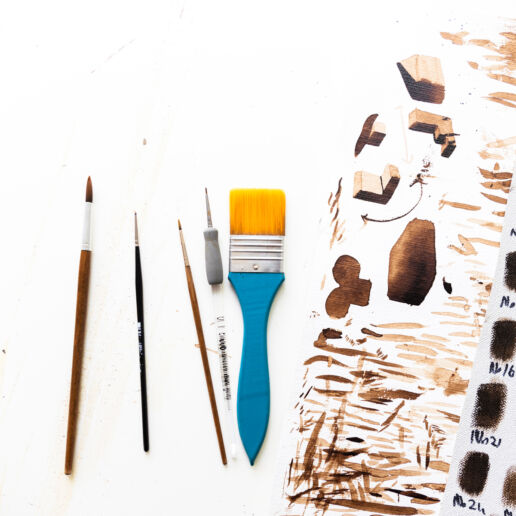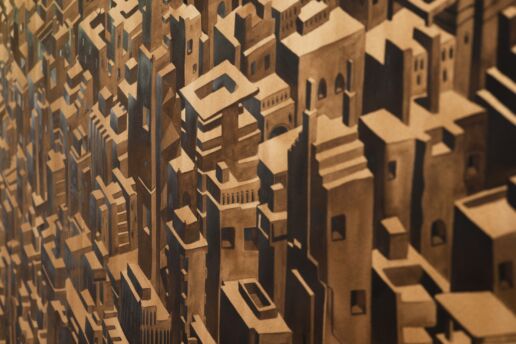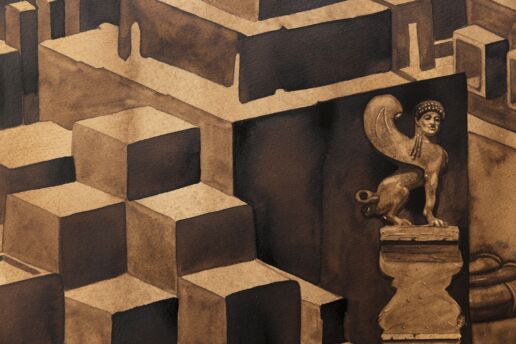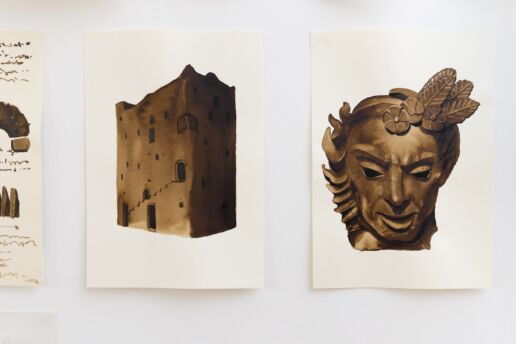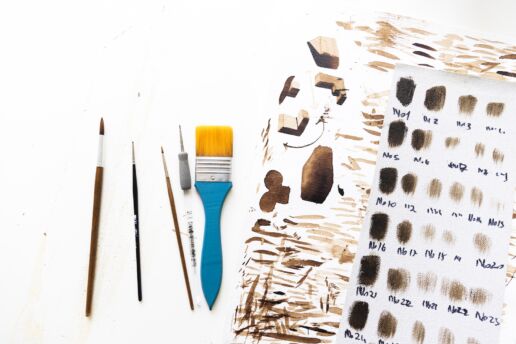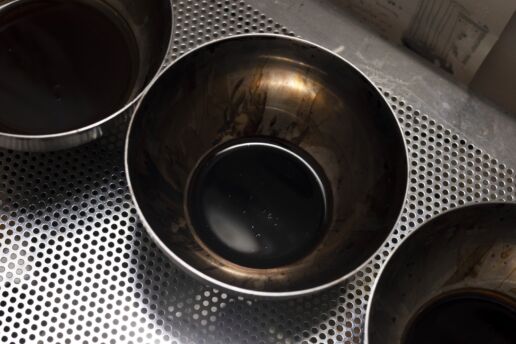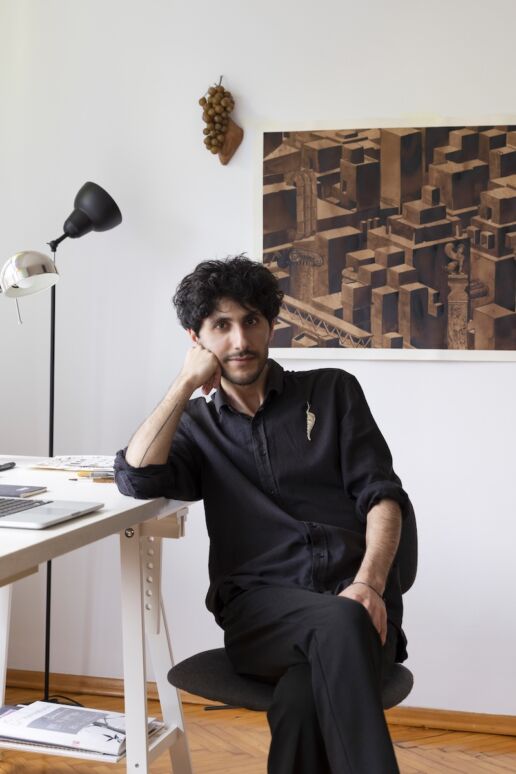HÜSEYİN AKSOY – A curious soul that flows like a river
I find myself in a living room where soft afternoon sun pours through the windows onto the wooden floor. The walls are covered with unusual but somewhat familiar cities cut out of paper in earth tones. Artist Hüseyin Aksoy opens the door to his studio with a bright smile. Here, we will talk about the charm of ancient ruins, discoveries induced by laziness, curiosities that have lasted from childhood, and rivers that invariably take us to different places.Photography Nazlı Erdemirel
In his latest exhibition, “Dens of the Birds,” Aksoy focuses on an old photograph he stumbled upon that led him to the story of Gertrude Bell, the British writer, traveller, and archeologist who spent much of her life, far from home, in Mesopotamia in order to conduct research during the late 19th and early 20th centuries. Following in Bell’s footsteps, Aksoy tries to make sense of his existence rooted in southeast Turkey, where he was born and grew up, and to better understand this land once marred by dark passions. The work in the gallery conveys a profound and curious feeling that is difficult to describe. Centuries-old Mesopotamian busts, dismantled wall sections, sculptures floating in the air… Aksoy created these synthesised depictions of structures past and present using German walnut paint and local pigments made from the earth. The walnut paint has become an obsession for him, and something he has often experimented with, since the exhibition in 2022, when a friend gave him some as a gift: “I felt like this novel material was getting in the way of the exhibition’s message. And yet it became an instrumental material for me. It still is.”
“Our heads are round, so our thoughts can change direction.”
Although it can be a challenge to follow Aksoy’s train of thought, he always has something unique to say that keeps one’s interest kindled. “I agree wholeheartedly with a quote by Francis Picabia: ‘Our heads are round, so our thoughts can change direction.’ My thoughts, the materials I use, the events that interest me, and the traces that fascinate me evolve and change constantly.” Aksoy has been contemplating ruins for a long time now. The destruction of something that exists and it’s turning into a ruin. He asks questions we all want to ask: “I wonder who lived here?” “What kind of life did they lead?”
While thinking about all the possibilities, he studies archeology and architecture. He realises how the words “civilisation” and “culture” have become synonymous over time. He investigates why both terms are closely associated with the concept of “city”. The cities that the artist builds with the rich, inky stains of his pigments crowd the white sheets of paper hanging on his living room walls. In one, pigeons perch on windowsills overlooking one of the quiet streets of Kalamış in Istanbul. In his cities, he conceals sections of ruins, those that already exist and those that have not yet tumbled down.
According to the artist, his work is about “bringing together” rather than “mixing.” He travels to cities that have been called “dead.” “I’m intrigued by people’s dreams of founding civilizations in different parts of the world and how each civilisation has arisen and survived over the centuries. The idea that the people who designed the city also govern the lives of its inhabitants excites me. It’s an amazing thing to be able to peruse the ruins, exploring layers of civilisations built on top of each other. I wonder why people needed taller buildings to get closer to the sky. I liken the collapse of the Tower of Babel, which was built with the aspiration of reaching God, to the alienation from ourselves as we become alienated from soil we used to till. When we sever our ties with the soil, we forget that we are mortal beings,” he says before recalling a conversation he once had with his grandfather. “I asked him why the houses in Mardin were only a single story, and why people walked barefoot in the house. He explained that our feet must touch the dirt to remember that we came from dirt and are mortal beings.”
Wild Rue
At this point, Aksoy begins to talk about memory and the act of remembering. “I don’t forget things. I also have a hard time throwing things away. I think I inherited this trait from my mother,” he says. Instead of discarding old clothes, many mothers and grandmothers would patch them. Younger children would wear the garments handed down by their older siblings. Buttons were saved, frugally, for a rainy day. Aksoy occasionally delves into these reflexive “practices of upcycling” with which previous generations were so familiar. So, it is not surprising that he came across a house-shaped ornament that he remembered hanging on the wall in his childhood home and started pursuing it years later. He observed that wild rue (Peganum harmala) thrives in cemeteries and, in particular, around ruins. He explains how this ancient plant, which favours phosphorus-rich soils, prospers on human burial sites rich in this nutrient. He is even more fascinated by the fact that in Iran and Turkey, people dry the pods of wild rue , which have flourished in proximity to death and decay, and then string them in the shape of a house and hang them in their homes to protect against evil. “As the connection dawned on me, I asked, ‘Can I associate my artistic production with wild rue?’ The phosphorus in human remains gives birth to new life. This resembles the new cities that rise from ruins in my work,” he says. His words make me remember one of Rilke’s letters from “The Dark Interval”: ‘Just like the moon, life surely has a side that is permanently turned away from us, and which is not its opposite but its complement.”
A dialogue between water and paper
“So where exactly does the construction of new life begin?” Aksoy’s answer to this question is like leaves surrendering to the flow of a river. “It begins with the marks I create with powdered pigments diluted with water. You leave a mark on a piece of white paper, a single dot. If you keep going, it turns into a stain and that is what eventually yields a work of art. Ultimately, we all try to leave our mark by doing something or another. It’s the same feeling whether we are walking, staying at home or making art. Why? We must begin to think. Is it because we are obsessed with immortality? So that our legacies prevail after we die? Is it the urge to say, ‘I’m still here?’ First, I design a city square and from there, I develop the city. I want to establish a dialogue between water and paper. I intuitively use whatever is available in my mind.” According to Aksoy, laziness gives way to activity, curiosity and productivity. “If you sit idle for too long, you’ll get bored and want to do something. Having that feeling of inertia finally drives us to do something. We are never supposed to let ourselves get bored, but I actually make time to stop and get bored deliberately. Maybe that’s why I’m curious and why I spend time researching and discovering before I start producing.’


